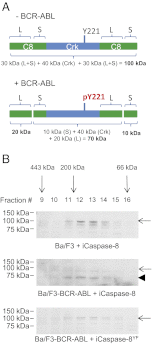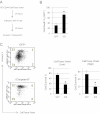Engineering a BCR-ABL-activated caspase for the selective elimination of leukemic cells
- PMID: 23324740
- PMCID: PMC3568344
- DOI: 10.1073/pnas.1206551110
Engineering a BCR-ABL-activated caspase for the selective elimination of leukemic cells
Abstract
Increased understanding of the precise molecular mechanisms involved in cell survival and cell death signaling pathways offers the promise of harnessing these molecules to eliminate cancer cells without damaging normal cells. Tyrosine kinase oncoproteins promote the genesis of leukemias through both increased cell proliferation and inhibition of apoptotic cell death. Although tyrosine kinase inhibitors, such as the BCR-ABL inhibitor imatinib, have demonstrated remarkable efficacy in the clinic, drug-resistant leukemias emerge in some patients because of either the acquisition of point mutations or amplification of the tyrosine kinase, resulting in a poor long-term prognosis. Here, we exploit the molecular mechanisms of caspase activation and tyrosine kinase/adaptor protein signaling to forge a unique approach for selectively killing leukemic cells through the forcible induction of apoptosis. We have engineered caspase variants that can directly be activated in response to BCR-ABL. Because we harness, rather than inhibit, the activity of leukemogenic kinases to kill transformed cells, this approach selectively eliminates leukemic cells regardless of drug-resistant mutations.
Conflict of interest statement
The authors declare no conflict of interest.
Figures






Similar articles
-
PLK1 inhibitors synergistically potentiate HDAC inhibitor lethality in imatinib mesylate-sensitive or -resistant BCR/ABL+ leukemia cells in vitro and in vivo.Clin Cancer Res. 2013 Jan 15;19(2):404-14. doi: 10.1158/1078-0432.CCR-12-2799. Epub 2012 Nov 30. Clin Cancer Res. 2013. PMID: 23204129 Free PMC article.
-
Synergistic interactions between DMAG and mitogen-activated protein kinase kinase 1/2 inhibitors in Bcr/abl+ leukemia cells sensitive and resistant to imatinib mesylate.Clin Cancer Res. 2006 Apr 1;12(7 Pt 1):2239-47. doi: 10.1158/1078-0432.CCR-05-2282. Clin Cancer Res. 2006. PMID: 16609040
-
Pharmacologic mitogen-activated protein/extracellular signal-regulated kinase kinase/mitogen-activated protein kinase inhibitors interact synergistically with STI571 to induce apoptosis in Bcr/Abl-expressing human leukemia cells.Cancer Res. 2002 Jan 1;62(1):188-99. Cancer Res. 2002. PMID: 11782377
-
The emerging role of Bcr-Abl-induced cystoskeletal remodeling in systemic persistence of leukemic stem cells.Curr Drug Deliv. 2014;11(5):582-91. doi: 10.2174/156720181105140922123610. Curr Drug Deliv. 2014. PMID: 23517626 Review.
-
Clinical targeting of mutated and wild-type protein tyrosine kinases in cancer.Mol Cell Biol. 2014 May;34(10):1722-32. doi: 10.1128/MCB.01592-13. Epub 2014 Feb 24. Mol Cell Biol. 2014. PMID: 24567371 Free PMC article. Review.
Cited by
-
Gold Nanoparticles for BCR-ABL1 Gene Silencing: Improving Tyrosine Kinase Inhibitor Efficacy in Chronic Myeloid Leukemia.Mol Ther Nucleic Acids. 2017 Jun 16;7:408-416. doi: 10.1016/j.omtn.2017.05.003. Epub 2017 May 8. Mol Ther Nucleic Acids. 2017. PMID: 28624216 Free PMC article.
-
Reprogramming Caspase-7 Specificity by Regio-Specific Mutations and Selection Provides Alternate Solutions for Substrate Recognition.ACS Chem Biol. 2016 Jun 17;11(6):1603-12. doi: 10.1021/acschembio.5b00971. Epub 2016 Mar 31. ACS Chem Biol. 2016. PMID: 27032039 Free PMC article.
References
-
- Deininger MW, Goldman JM, Melo JV. The molecular biology of chronic myeloid leukemia. Blood. 2000;96(10):3343–3356. - PubMed
-
- Wong S, Witte ON. The BCR-ABL story: Bench to bedside and back. Annu Rev Immunol. 2004;22:247–306. - PubMed
-
- Gorre ME, Sawyers CL. Molecular mechanisms of resistance to STI571 in chronic myeloid leukemia. Curr Opin Hematol. 2002;9(4):303–307. - PubMed
-
- Michor F, et al. Dynamics of chronic myeloid leukaemia. Nature. 2005;435(7046):1267–1270. - PubMed
-
- Graham SM, et al. Primitive, quiescent, Philadelphia-positive stem cells from patients with chronic myeloid leukemia are insensitive to STI571 in vitro. Blood. 2002;99(1):319–325. - PubMed
Publication types
MeSH terms
Substances
Grants and funding
- R01 CA153126/CA/NCI NIH HHS/United States
- R01 HL082978-01/HL/NHLBI NIH HHS/United States
- K99 CA140948/CA/NCI NIH HHS/United States
- R01 CA123350/CA/NCI NIH HHS/United States
- DP1 CA174422/CA/NCI NIH HHS/United States
- R01 HL108006/HL/NHLBI NIH HHS/United States
- R01 CA102707/CA/NCI NIH HHS/United States
- R01 HL097767/HL/NHLBI NIH HHS/United States
- P01 CA049639-20A2/CA/NCI NIH HHS/United States
- R00 CA140948/CA/NCI NIH HHS/United States
- R01 HL082978/HL/NHLBI NIH HHS/United States
- P01 CA049639/CA/NCI NIH HHS/United States
LinkOut - more resources
Full Text Sources
Other Literature Sources
Medical
Molecular Biology Databases
Research Materials
Miscellaneous

